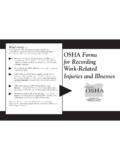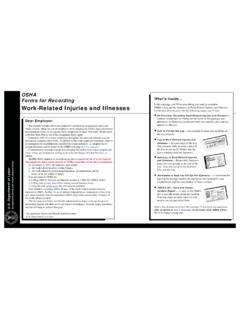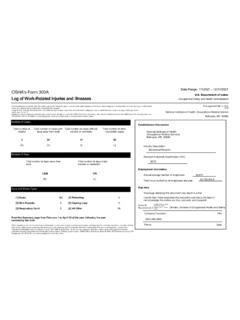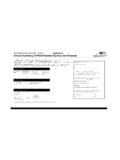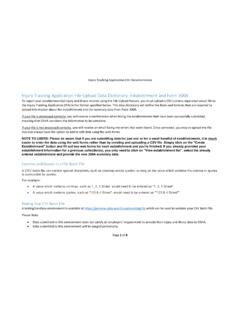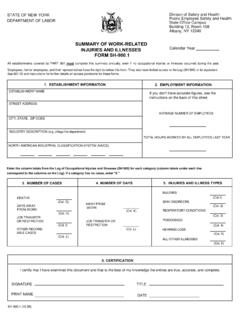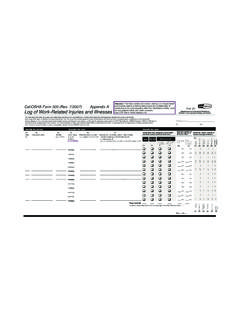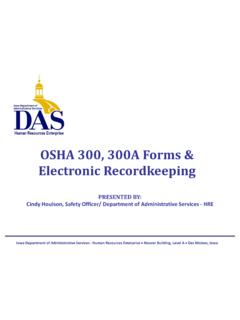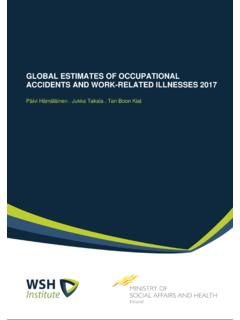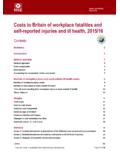Transcription of In this package, you’ll find everything you need to ...
1 OSHA Forms for Recording work - related injuries and illnesses Dear Employer: This booklet includes the forms needed for maintaining occupational injury and illness records. Many but not all employers must complete the OSHA injury and illness recordkeeping forms on an ongoing basis. Employers in State Plan States should check with their State Plan to see if the exemptions below apply. Employers with 10 or fewer employees throughout the previous calendar year do not need to complete these forms. In addition to the small employer exemption, there is an exemption for establishments classified in certain industries. A complete list of exempt industries can be found on the OSHA web page at https:// Establishments normally exempt from keeping the OSHA forms must complete the forms if they are informed in writing to do so by the Bureau of Labor Statistics or OSHA.
2 All employers, including those partially exempted by reason of company size or industry classification, must report to OSHA any workplace incident that results in a fatality, in-patient hospitalization, amputation, or loss of an eye. You can report to OSHA by calling OSHA's free and confidential number at 1-800-321- OSHA (6742); calling your closest Area Office during normal business hours; or by using the online reporting form at Many employers are required to electronically submit information from their Form 300A summary to OSHA. To see if your establishment is required to submit the information, visit The Occupational Safety and Health Administration shares with you the goal of preventing injuries and illnesses in our nation's workplaces. Accurate injury and illness records will help us achieve that goal.
3 Occupational Safety and Health Administration Department of Labor What s In this package, you ll find everything you need to complete OSHA s Log and the summary of work - related injuries and illnesses for the next several years. On the following pages, you ll find: An Overview: Recording work - related injuries and illnesses General instructions for filling out the forms in this package anddefinitions of terms you should use when you classify your cases asinjuries or illnesses . How to Fill Out the Log An example to guide you in filling out theLog properly. Log of work - related injuries andIllnesses A copy of the Log (but youmay make as many copies of the Log asyou need.) Notice that the Log isseparate from the summary . summary of work - related Injuriesand illnesses Removable Summarypages for easy posting at the end of theyear.
4 Note that you post the Summaryonly, not the Log. Worksheet to Help You Fill Out the summary A worksheet forfiguring the average number of employees who worked for yourestablishment and the total number of hours worked. OSHA s 301: Injury and IllnessIncident Report A copy of the OSHA301 to provide details about the may make as many copies as youneed or use an equivalent a few minutes to review this package. If you have any questions, visit us online at or call your local OSHA office. We ll be happy to help you. Department of Labor Occupational Safety and Health Administration An Overview: Recording work - related injuries and illnesses The Occupational Safety and Health (OSH) Act of 1970 requires certain employers to prepare and maintain records of work - related injuries and illnesses . Use these definitions when you classify cases on the Log.
5 OSHA s recordkeeping regulation (see 29 CFR Part 1904) provides more information about the definitions below. What do you need to do? 7 calendar days after you receiveinformation about a case, decide if thecase is recordable under the OSHA recordkeeping whether the incident is a newThe Log of work - related injuries and illnesses (Form 300) is used to classify work - related injuries and illnesses and to note the extent and severity of each case. When an incident occurs, use the Log to record specific details about what happened and how it happened. The summary a separate form (Form 300A) shows the totals for the year in each category. At the end of the year, post the summary in a visible location so that your employees are aware of the injuries and illnesses occurring in their workplace. Employers must keep a Log for each establishment or site.
6 If you have more than one establishment, you must keep a separate Log and summary for each physical location that is expected to be in operation for one year or longer. Note that your employees have the right to review your injury and illness records. For more information, see 29 Code of Federal Regulations Part , Employee Involvement. Cases listed on the Log of work - related injuries and illnesses are not necessarily eligible for workers compensation or other insurance benefits. Listing a case on the Log does not mean that the employer or worker was at fault or that an OSHA standard was violated. When is an injury or illness considered work - related ? An injury or illness is considered work - related if an event or exposure in the work environment caused or contributed to the condition or significantly aggravated a preexisting condition.
7 work -relatedness is presumed for injuries and illnesses resulting from events or exposures occurring in the workplace, unless an exception specifically applies. See 29 CFR Part (b)(2) for the exceptions. The work environment includes the establishment and other locations where one or more employees are working or are present as a condition of their employment. See 29 CFR Part (b)(1). Which work - related injuries and illnesses should you record? Record those work - related injuries and illnesses that result in: death, loss of consciousness, days away from work , restricted work activity or job transfer, or medical treatment beyond first aid. You must also record work - related injuriesand illnesses that are significant (as defined below) or meet any of t he additional criteria listed below. You must record any significant work - related injury or illness that is diagnosed by a physician or other licensed health care professional.
8 You must record any work - related case involving cancer, chronic irreversible disease, a fractured or cracked bone, or a punctured eardrum. See 29 CFR What are the additional criteria? You must record the following conditions when they are work - related : any needlestick injury or cut from a sharpobject that is contaminated with anotherperson s blood or other potentially infectiousmaterial; any case requiring an employee to bemedically removed under the requirementsof an OSHA health standard; tuberculosis infection as evidenced by apositive skin test or diagnosis by a physicianor other licensed health care professionalafter exposure to a known case of activetuberculosis; an employee's hearing test (audiogram)reveals 1) that the employee has experienceda Standard Threshold Shift (STS) in hearingin one or both ears (averaged at 2000, 3000,and 4000 Hz) and 2) the employee's totalhearing level is 25 decibels (dB) or moreabove audiometric zero (also averaged at2000, 3000, and 4000 Hz) in the same ear(s)as the is medical treatment?
9 Medical treatment includes managing and caring for a patient for the purpose of combating disease or disorder. The following are not considered medical treatments and are NOT recordable: visits to a doctor orhealth care professionalsolely for observation or counseling;case or a recurrence of an existing whether the case was work - the case is recordable, decide whichform you will fill out as the injury andillness incident may use OSHA s 301: Injuryand Illness Incident Report or anequivalent form. Some state workerscompensation, insurance, or other reportsmay be acceptable substitutes, as long asthey provide the same information as theOSHA to work with the Log the employee involved unless it isa privacy concern case as when and where the caseoccurred. Also describe the case, asspecifically as you the seriousness of the case byrecording the most serious outcomeassociated with the case, with column G(Death) being the most serious andcolumn J (Other recordable cases) beingthe least the number of days the injured or illworker was away from work or was onjob transfer or restricted work whether the case is an injury orillness.
10 If the case is an injury, check theinjury category. If the case is an illness,check the appropriate illness Department of Labor Occupational Safety and Health Administration diagnostic procedures, including administeringprescription medications that are used solelyfor diagnostic purposes; and any procedure that can be labeled first aid. (Seebelow for more information about first aid.)What is first aid? If the incident required only the following types of treatment, consider it first aid. Do NOT record the case if it involves only: using non-prescription medications at non- prescription strength; administering tetanus immunizations; cleaning, flushing, or soaking wounds on theskin surface; using wound coverings, such as bandages,BandAids , gauze pads, etc., or usingSteriStrips or butterfly bandages; using hot or cold therapy; using any totally non-rigid means of support,such as elastic bandages, wraps, non-rigid backbelts, etc.










